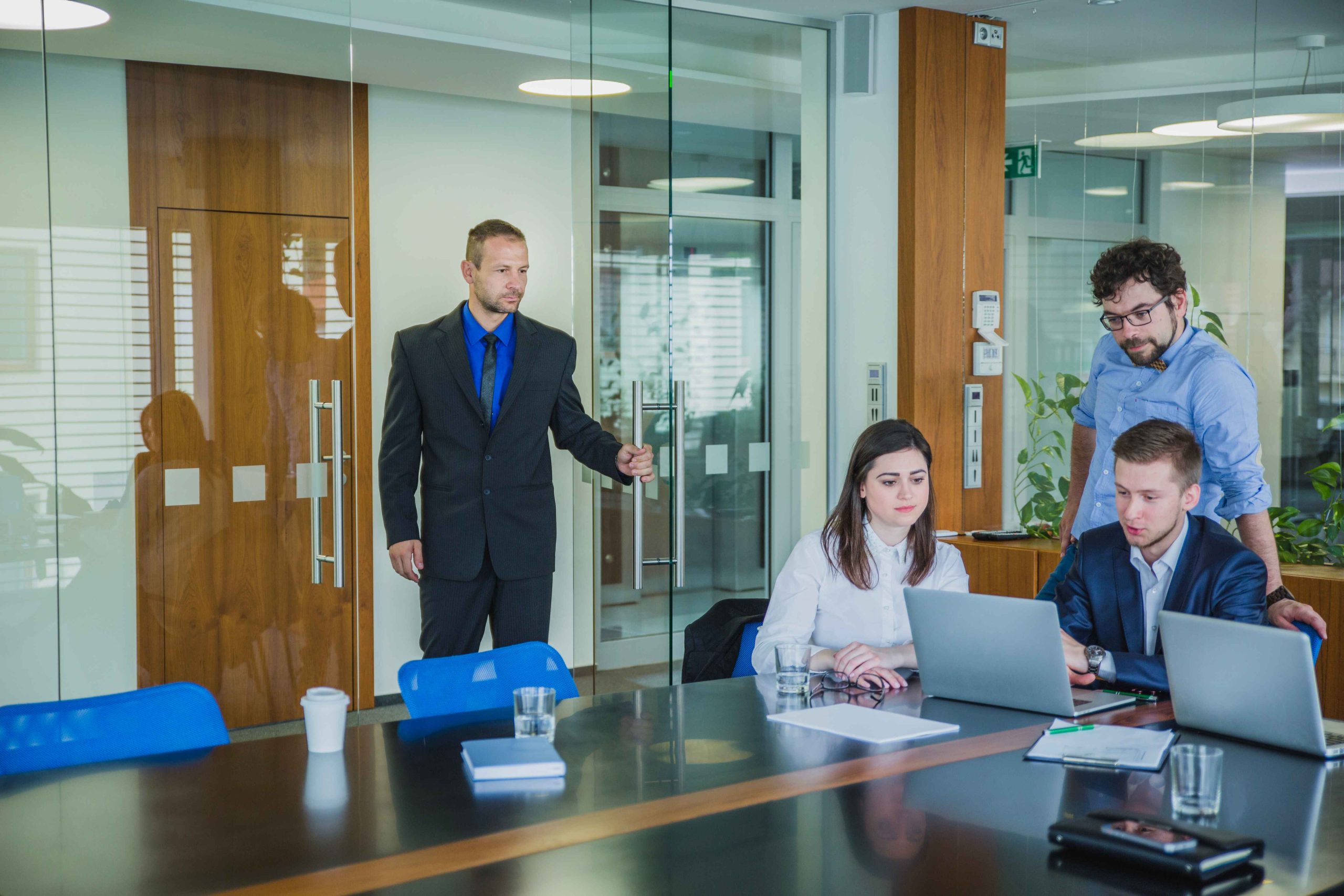Flexible office space is a type of space designed to give employees different places and ways to work. Unlike traditional offices with fixed and assigned desks, workers in these office spaces can choose the area of the office that best suits the type of work they need to do at the time.
In this article, we will explain how flexible workspaces can be rearranged to accommodate changing business goals or scaled up or down to accommodate teams of different sizes. This type of dynamic office space has its design for its use in conjunction with flexible work arrangements that give teams the freedom to work where, when, and how they want.
- What is a flexible job?
- Important aspects of a flexible workspace
- Benefits of a flexible workspace in Dubai
- The importance of office design
- How to implement a flexible space in your office?
- What is the importance of synergy in a flexible workplace?
- More advantages of a flexible workplace in Dubai
- How can Connect Business Centers help you obtain more information about flexible workplaces?
1. What is a Flexible Job?
Flexible work is a term used to describe any work pattern that goes beyond conventional office hours or locations. That may mean working in different locations in the same office, working from home or on a remote desk, or working part-time or staggered hours.
Employees who do not have to stick to inconvenient hours or put up with busy commutes are not only able to spend more of their time and energy doing great work. They are also generally happier and more productive than their colleagues who work exclusively from offices.
Flexible working gives the opportunity to work how and where they want, fostering a healthy work-life balance in the process. By choosing their own hours, employees can work around their duties. Like going to a doctor’s appointment or picking up a child from school, while avoiding rush-hour traffic and crowded trains.
Flexible working not only gives employees the ability to work in a way that suits their specific needs. It also helps companies cut costs and make the most of their office layout by maximizing available space.
2. Important Aspects of a Flexible Workspace
Flexible office spaces adapt to the unique and changing needs a company has at any given time, so of course, every office will look different. However, there are a number of basic elements found in most flex spaces. Each of these will promote versatility and a collaborative environment.
- Open designs. The first open-space offices emerged more than a century ago in New York City. However, today’s best-known style of open floor plans was popularized in the 1960s. When interior designers were looking for ways to efficiently accommodate larger teams by eliminating physical walls between workers. Today, the open office concept is widespread. It is a primary aspect of a flexible workspace, allowing seamless collaboration between different departments.
- Quiet areas. A well-documented side effect of open office design is increased ambient noise. Flexible workspaces lessen this problem by designating quiet areas that give workers a place where they can focus on their tasks without being interrupted. They come in many shapes and sizes, from open spaces and quiet corners of a building to private, soundproof phone booths.
- Adaptable workstations. Flexible office spaces often include non-traditional workstation styles. Standing desks in shared areas endorse the idea of moving around to use the zone in many different ways. In relaxed corners of the office, such as cafeterias and reception areas, comfortable chairs and natural lighting create flexible, welcoming spaces where people will want to linger.
- Shared amenities. When tied to one place, people tend to store things on the desk area that they need for different purposes. A flexible space unifies these resources and makes them accessible to everyone who wants them. These shared services can be office supplies, printers, snacks, or entire spaces, such as meeting rooms or informal common areas.
3. Benefits of a Flexible Workspace in Dubai
A flexible workspace removes many of the barriers to productivity that a traditional office workspace presents. An example could be a typical project schedule. Which might start with a series of short, informal face-to-face meetings between a group of people before a larger, more structured conversation begins.
In a traditional office workspace, all of these stages occur in one location. Even though the space needs of the project change over time. However, thanks to the flexible office space industry, people can choose a location that makes the most sense for the work they are doing at the time.
That might mean working from a laptop in a quiet area, using a casual shared space to catch up with other team leaders over coffee, or taking a day or two to work remotely. A well-designed flexible workspace in Dubai gives employees the space they need to work best on their terms.
For entrepreneurs, flexible workspaces industries offer other benefits beyond productivity. More adaptable office layouts allow fast-moving businesses to expand during periods of growth when fewer workers come into the office. Dynamic spaces that can be easily reconfigured help design socially distanced office layouts, a key challenge in ensuring worker safety in these times.
4. The Importance of Office Design
The COVID-19 pandemic has brought renewed attention to the design and layout of our public spaces. The way we get around our cities has changed, and as restrictions ease and we gradually go back to bars, restaurants, gyms, and offices, the way we use interior spaces will change too.
Most workspaces have adapted to social distancing guidelines by reconfiguring desk layouts, and improving their cleaning routine systems. The flexible workspace industry helps businesses meet this particular challenge with minimal disruption by allowing teams to easily spread out over a larger space or work remotely.
If we think beyond the pandemic, a good office layout is one that optimizes security, comfort, and functionality. A flexible office space improves productivity by giving teams access to shared spaces and the resources they need to get work done.
When employees have support from an office design that encourages creativity and responds to their changing needs, whether it is over the course of a project or the day, they have an easier time meeting their goals.
5. How to Implement a Flexible Space in Your Office?
Creating a flexible office space is much more than just placing a couple of armchairs next to the coffee machine. An agile work environment must also be fostered, which promotes the idea of using different areas when necessary. Changing your office layout is the easy part, but changing your culture is the hard part.
Try to remove the formality from spaces that are usually reserved for a single purpose. The boring meeting room you only use for the monthly meeting could be the perfect space for an activity-based workspace or just a space to catch up on emails. Meeting modules and comfortable furniture can create quiet areas in open-plan offices without the need to build bulky room dividers.
Technology plays an important role in the design of a flexible office. Make sure there are easily accessible outlets for charging devices next to most seats and a strong network for wireless data in every corner of the office. Standardize the audio-visual setup of presentations across rooms to make it as easy as possible to hold meetings anywhere in the office.
We are creatures of habit. It can take a while for a company to adjust to a new way of working. But by creating a flexible space and being responsive to how your teams use it, you can begin to realize the benefits of flexible workspace trends.
6. What is the importance of synergy in a flexible workplace?
Working close to people from other sectors, branches or areas favors obtaining better results. Sharing a workspace with other professionals can thus be beneficial for your company. You will not only have the opportunity to meet people who may interest you at a work level, but you will also be able to share enriching personal experiences.
In the same way that there are flexible spaces that you can share with people outside your community. There is also the option of choosing a private flexible space for employees of the same company.
Choosing flexible space industries in these cases often favors work-life balance and reduces the carbon footprint of your team. As well as promoting communication and a good work environment, essential for achieving good results and being more efficient.
Another reason why it is interesting to choose this type of office is because of the additional services they offer. From reception service to specific connectivity solutions, printing, event rooms, home delivery, and even a gym or showers in some cases. These benefits allow you to design your perfect office and pay for what you really use.
Not all companies are the same and therefore not all needs neither surface nor services are going to be the same. Just as traditional offices force you to have a fixed area, manage all the suppliers (cleaning, maintenance, etc.) and pay for all the supplies, one of the advantages that the flexible workspace industry has is the cost savings exclusively for the services for both space and benefits.
The trend of flexible workspaces can also offer a hybrid alternative to traditional rental offices. Providing a more sustainable environment in which to work with your team physically while combining it with telecommuting.
7. More advantages of a flexible workplace in Dubai
7.1 Increase employee well-being and collaboration.
Overnight, remote work and virtual offices became the norm for many. Consequently, employees without home offices had to transform their bedrooms, living rooms, or even kitchens into makeshift offices. Family distractions, Zoom fatigue, and a lack of face-to-face collaboration with colleagues have made things increasingly difficult for many.
The solution to that problem comes with the trend of flexible offices, as they allow companies to provide their employees with workspaces close to home where they can work on individual or crew jobs while feeling safe and relaxed.
Another vital benefit of flex spaces is the positive impact they have on the environment. They have a considerable amount of foresight when it comes to people’s needs, which change dramatically every 10-15 years.
Whenever a building ceases to be relevant and useful to its occupants, it usually undergoes extensive reconstruction or even demolition, creating huge amounts of waste. This is not the case with this office space trend, as their modular and sustainable designs allow companies to modify work areas without generating more waste or spending large amounts of money on reconstruction or renovation.
7.2. They reduce overhead
Flexible offices allow some businesses to avoid the commitment of a traditional long-term lease and the associated operating expenses incurred. For this reason, they are cheaper than renting a traditional office space in the main cities, of course, the costs of these can vary depending on the market, the provider, or the location of the offices.
On the other hand, unlike traditional leases, co-working spaces come with all the basics (i.e. printing equipment, office furniture, Wi-Fi and phone services, utilities and event spaces, and other amenities), included in your subscriptions.
7.3. Greater visibility
Working from a flexible office increases the visibility of an organization which brings several benefits. One of them is the one that allows you to do networking that will help you discover new talents that you want to include in your company and meet potential clients.
8. How can Connect Business Centers help you obtain more information about flexible workplaces?
Due to the Covid-19 outbreak and some other issues, flexible offices are becoming significant in the way we will work during the following decade. Modern companies are taking measurements and must familiarize themselves with this practice. In addition, flexible workspaces offer corporations many advantages and benefits important to allow your business to gro
Connect Business Centers
![]() Connect Business CentersConnect business centers is a real estate marketplace dedicated to helping homeowners, home buyers, sellers, renters and agents find and share information about homes, real estate and home improvement.
Connect Business CentersConnect business centers is a real estate marketplace dedicated to helping homeowners, home buyers, sellers, renters and agents find and share information about homes, real estate and home improvement.




